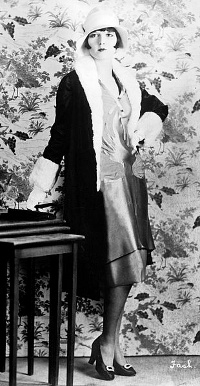The Great Gatsby Contents
The Jazz Age
Fitzgerald labels the era
‘The Jazz Age’ was a term coined by Fitzgerald himself to describe the 1920s, in his work Echoes of the Jazz Age (1931). He commented that:
The essay as a whole characterised the period in terms of its cultural identity but the use of the word ‘jazz’ gives recognition to the growing popularity of jazz music, although the word itself, ‘meant first sex, then dancing, then music’. The dancing and music originated in black American culture, which was popularised by white middle-class Americans. Flappers danced to jazz, doing the ‘Charleston’ and the ‘Black Bottom’ among other popular styles.
Attitudes towards women
Economic independence
Following the First World War, American women were increasingly emancipated, in dress and behaviour just as much as economically. They were given the vote in 1920, although this did not immediately mean greater representation or any change in political power for women. However, since the First World War women had begun to enter the workplace in greater numbers, which altered their economic circumstances. As a result, there was a social shift as financially independent women started to challenge old ideas of female roles and propriety, reaching towards greater freedom and equality. Inevitable, more affluent women were able to achieve greater independence than their poorer counterparts.
‘Flappers’
 Zelda was regarded by her husband as ‘the first American flapper’. The Flapper image was very bold in breaking with conventions of decorous dress. Conventional corsets and restrictive dresses were discarded in favour of wearing shorter skirts, revealing parts of the leg, and women began to display bare arms, bobbed hair and heavy make-up. In terms of behaviour, Flappers were notorious for smoking, drinking, driving cars and for their casual attitudes towards sex and ‘petting’.
Zelda was regarded by her husband as ‘the first American flapper’. The Flapper image was very bold in breaking with conventions of decorous dress. Conventional corsets and restrictive dresses were discarded in favour of wearing shorter skirts, revealing parts of the leg, and women began to display bare arms, bobbed hair and heavy make-up. In terms of behaviour, Flappers were notorious for smoking, drinking, driving cars and for their casual attitudes towards sex and ‘petting’.
Women who were politically engaged in fighting for emancipation viewed Flappers as somewhat frivolous, but their challenge to authority and morality was a serious one, with far-reaching consequences for later feminist movements. Zelda Fitzgerald saw herself as a ‘new woman’, in that she broke many of the rules governing female behaviour. However, she still struggled to establish her own identity as an artist, despite being a talented writer, painter and dancer.
Alcohol and prohibition
Prohibition began in America in 1920 and continued until 1933, meaning that the manufacture and sale of alcohol was illegal, although drinking itself was not. This was intended to protect the citizens from the damaging effects of alcohol upon society, but in fact fostered the growth of criminal gangs, bribery and corruption, and some historians believe it may have even encouraged drinking.
‘Speakeasies’ were the illegal bars where people congregated in large numbers to buy and consume alcohol, controlled by gangsters across the country, such as Al Capone and his rival Bugs Moran in Chicago. Gatsby is accused by Tom of being a ‘bootlegger’ or smuggler of alcohol, using ‘drugstores’ as a cover for the selling of alcohol, since the law allowed for whisky to be sold as long as it was ‘for medical purposes only’.
Crime
Bolstered by the opportunities provided by Prohibition, organised crime, run by gangs which developed into the American Mafia, was a significant issue in 1920s America. This was problematic enough for society but the implications of organised crime were that institutions were also corrupted, with bribery, blackmail and insider crime damaging the effectiveness of the police, the justice system and the government.
Fitzgerald depicts some of this in The Great Gatsby:
- Gatsby escapes punishment for speeding
- Wolfsheim is able to ‘fix’ the World Series
- Jordan Baker is recognised as having cheated in golf but gets away with it.
Most important is the insinuation that Gatsby and Wolfsheim are gangsters, and the sense that all wealth is implicated in crime somehow, since Daisy and Tom are equally guilty of covering up Daisy’s killing of Myrtle.
